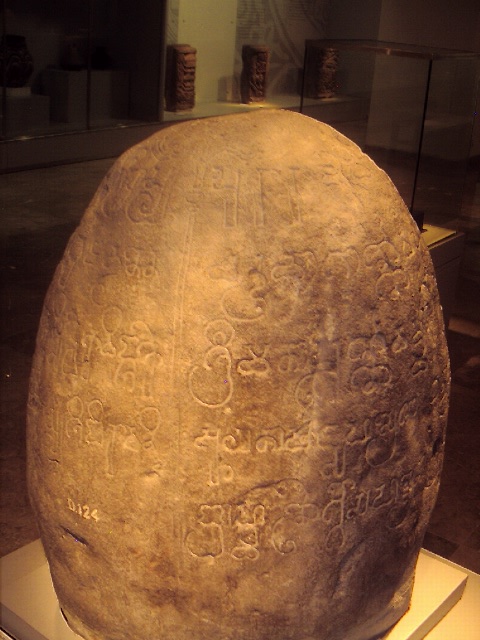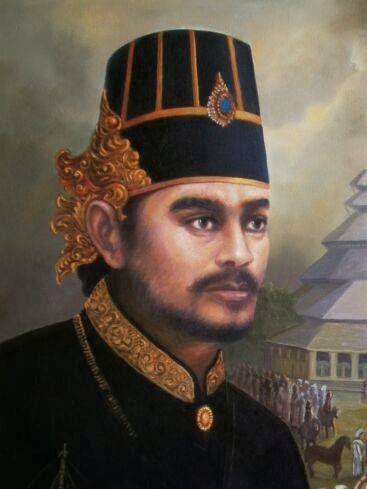|
Purnawarman
Purnawarman or Purnavarman is the 5th-century king of Tarumanagara, a Hindu Indianized kingdom, located in modern-day West Java, Jakarta and Banten provinces, Indonesia. Purnawarman reigned during the 5th century, and during his reign he created several stone inscriptions. According to these inscriptions he embarked on hydraulic project and also identified himself to Vishnu, which indicates him and his kingdom were adhering Vishnuite faith. King Purnawarman established a new capital city for the kingdom, located somewhere near present-day Tugu (North Jakarta) or Bekasi. His name in Sanskrit means "perfect shield" or "complete protector". Later series of Tarumanagaran kings are only known from their names, all bears the name ''warman'' (Sanskrit: ''varman'' means "shield" or "protector") which suggests that all of them belongs in the same dynasty. Historiography Purnawarman is the most well known ruler among Tarumanagaran kings, mostly because he extensively created numbers o ... [...More Info...] [...Related Items...] OR: [Wikipedia] [Google] [Baidu] |
Tarumanagara
Tarumanagara or Taruma Kingdom or just Taruma is an early Sundanese Indianised kingdom, located in western Java, whose 5th-century ruler, Purnawarman, produced the earliest known inscriptions in Java, which are estimated to date from around 450 CE. At least seven stone inscriptions connected to this kingdom were discovered in Western Java area, near Bogor and Jakarta. They are Ciaruteun, Kebon Kopi, Jambu, Pasir Awi, and Muara Cianten inscriptions near Bogor; Tugu inscription near Cilincing in North Jakarta; and Cidanghiang inscription in Lebak village, Munjul district, south of Banten. Location The inscriptions of Taruma kingdom are the earliest records of Hinduism in the western part of the archipelago. The geographical position of coastal West Java, which corresponds to today modern Jakarta, is a commanding region that controls the Sunda Strait. This location is strategic in regard to Sumatra, and also its connection to Asian continent of India and China. The king ... [...More Info...] [...Related Items...] OR: [Wikipedia] [Google] [Baidu] |
Ciaruteun Inscription
Ciaruteun inscription ( id, Prasasti Ciaruteun) also written Ciarutön or also known as Ciampea inscription is a 5th-century stone inscription discovered on the riverbed of Ciaruteun River, a tributary of Cisadane River, not far from Bogor, West Java, Indonesia. The inscription is dated from the Tarumanagara kingdom period, one of the earliest Hindu kingdoms in Indonesian history. The inscription states King Purnawarman is the ruler of Tarumanagara. Location and description Ciaruteun inscription is located in Ciaruteun Ilir village, Cibungbulang district, Bogor Regency; on coordinate 6°31’23,6” Latitude dan 106°41’28,2” Longitude. This location is approximately 19 kilometres Northwest of Bogor city center. The location is a small hill ( Sunda: ''pasir'') which is the confluence of three rivers: Cisadane, Cianten, and Ciaruteun. Until 19th century, the location is reported as part of Pasir Muara, which included into the private land of Tjampéa (Ciampea), although toda ... [...More Info...] [...Related Items...] OR: [Wikipedia] [Google] [Baidu] |
Tugu Inscription
The Tugu inscription is one of the early 5th century Tarumanagara inscriptions discovered in Batutumbuh hamlet, Tugu village, Koja, North Jakarta, in Indonesia. The inscription contains information about hydraulic projects; the irrigation and water drainage project of the Chandrabhaga river by the order of Rajadirajaguru, and also the water project of the Gomati river by the order of King Purnawarman in the 22nd year of his reign. The digging project to straighten and widen the river was conducted in order to avoid flooding in the wet season, and as an irrigation project during the dry season. In 1911 by the initiative of P. de Roo de la Faille, the Tugu inscription was moved to Museum Bataviaasch genootschap van Kunsten en Wetenschappen (now National Museum of Indonesia) with inventory number D.124. The inscription was carved on a round egg-like stone measuring about 1 metre. Content The Tugu inscription was written in Pallava script, arranged in the form of Sanskrit Slok ... [...More Info...] [...Related Items...] OR: [Wikipedia] [Google] [Baidu] |
Cidanghiang Inscription
Cidanghiang inscription, also called Lebak inscription, is an inscription from the Tarumanagara kingdom, estimated to be from the 4th century CE. The inscription was found in 1947 on the bank of Cidanghiang River in Lebak village, Munjul district, in Pandeglang Regency, Banten, Indonesia. The inscription is written in the Pallava script and composed in the Sanskrit language. Text This inscription mentions a king named Purnawarman, who used the title ''vikrānta'', which indicates that he was a worshiper of Lord Vishnu. It consists only of two lines, transliterated as follows: : : Translation The translation of this inscription according to philologist Poerbatjaraka (1952) is as follows: : ''This is the conqueror of the three worlds (with his three steps),'' : ''his majesty King Pūrnavarman, the great king, the hero (and) to be the banner of all kings in the worlds'' See also * Purnawarman * Tarumanagara Tarumanagara or Taruma Kingdom or just Taruma is an early ... [...More Info...] [...Related Items...] OR: [Wikipedia] [Google] [Baidu] |
Salakanagara
The Salakanagara Kingdom is the first historically recorded Indianised kingdom in Western Java. The kingdom existed between 130-362 AD. Claudius Ptolemaeus (160 AD) wrote about Java in his book, ''Geographie Hypogenesis''. He mentions the name of Argyre Chora (meaning: Silver Nation) in Labadio. According to the historian, Labadio means Dwipa-Javaka, Dwipa-Javaka or Java Dwipa, which is the ancient name of Java Island. There was one kingdom which rule west coast Java in 160 AD, Salakanagara. Salakanagara means “Silver Nation”. It reinforces the theory that Ptolemaeus may have visited Java in 160 AD. A relatively modern literature in the 17th century Pustaka Rajya Rajya i Bhumi Nusantara describes Salakanagara as being founded by an Indian merchant from Pallava Kingdom. Historiography The history of Salakanagara is quite mysterious as the historical and archaeological sources are scarce. Compared to its successor, Tarumanagara, the kingdom did not leave any local tangible ... [...More Info...] [...Related Items...] OR: [Wikipedia] [Google] [Baidu] |
Jakarta
Jakarta (; , bew, Jakarte), officially the Special Capital Region of Jakarta ( id, Daerah Khusus Ibukota Jakarta) is the capital city, capital and list of Indonesian cities by population, largest city of Indonesia. Lying on the northwest coast of Java, the world's list of islands by population, most populous island, Jakarta is the list of cities in ASEAN by population, largest city in Southeast Asia and serves as the diplomatic capital of ASEAN. The city is the economic, cultural, and political centre of Indonesia. It possesses a province-level status and has a population of 10,609,681 as of mid 2021.Badan Pusat Statistik, Jakarta, 2022. Although Jakarta extends over only , and thus has the smallest area of any Provinces of Indonesia, Indonesian province, its Jakarta metropolitan area, metropolitan area covers , which includes the satellite cities Bogor, Depok, Tangerang, South Tangerang, and Bekasi, and has an estimated population of 35 million , making it the List of m ... [...More Info...] [...Related Items...] OR: [Wikipedia] [Google] [Baidu] |
Banten
Banten ( id, Banten; Sundanese: , romanized ''Banten'') is the westernmost province on the island of Java, Indonesia. Its capital city is Serang. The province borders West Java and the Special Capital Region of Jakarta on the east, the Java Sea on the north, the Indian Ocean on the south, and the Sunda Strait (which separates Java from the neighbouring island of Sumatra) on the west. The province covers an area of . It had a population of over 11.9 million in the 2020 census, up from about 10.6 million in 2010.Badan Pusat Statistik, Jakarta, 2021. The estimated mid-2021 population was 12.06 million.Badan Pusat Statistik, Jakarta, 2022. Formerly part of the province of West Java, Banten was declared a separate province in 2000. The region is the homeland of the Bantenese people, whose culture differs slightly from that of West Java's Sundanese people. The northern half (particularly the areas near Jakarta and the Java Sea coast) has recently experienced rapid rises in po ... [...More Info...] [...Related Items...] OR: [Wikipedia] [Google] [Baidu] |
Pallava
The Pallava dynasty existed from 275 CE to 897 CE, ruling a significant portion of the Deccan, also known as Tondaimandalam. The dynasty rose to prominence after the downfall of the Satavahana dynasty, with whom they had formerly served as feudatories. The Pallavas became a major South Indian power during the reign of Mahendravarman I (600–630 CE) and Narasimhavarman I (630–668 CE), and dominated the southern Andhra Region and the northern parts of the Tamil region for about 600 years, until the end of the 9th century. Throughout their reign, they remained in constant conflict with both the Chalukyas of Badami in the north, and the Tamil kingdoms of Chola and Pandyas in the south. The Pallavas were finally defeated by the Chola ruler Aditya I in the 9th century CE. The Pallavas are most noted for their patronage of Hindu temple architecture, the finest example being the Shore Temple, a UNESCO World Heritage Site in Mamallapuram. Kancheepuram served as the capi ... [...More Info...] [...Related Items...] OR: [Wikipedia] [Google] [Baidu] |
Kebon Kopi I Inscription
Kebon Kopi I also known as Tapak Gajah inscription (elephant footprint inscription), is one of several inscriptions dated from the era of Tarumanagara Kingdom circa 5th century. The inscription bearing the image of elephant footprint, which was copied from the elephant ride of King Purnawarman of Tarumanagara, which is equated with Airavata, the elephant vahana (vehicle) of Indra. The inscription was discovered in Kebon Kopi village, Bogor, near Kebon Kopi II inscription, and named as such to differ it from this later inscription dated from Sunda Kingdom era. Content This inscription is written with Pallawa script in Sanskrit which are arranged into the form of the Anustubh metrum Shloka, which is flanked by a pair of carved images of the elephant's foot. Transcription: ''~ ~ jayavisalasya Tarumendrasya hastinah ~ ~'' ''Airwavatabhasya vibhatidam ~ padadvayam'' Translation: "Behold, here it looks like a pair of feet ...like Airavata, the elephant ride of the great Tarum ... [...More Info...] [...Related Items...] OR: [Wikipedia] [Google] [Baidu] |
Indonesian Hindu Monarchs
Indonesian is anything of, from, or related to Indonesia, an archipelagic country in Southeast Asia. It may refer to: * Indonesians, citizens of Indonesia ** Native Indonesians, diverse groups of local inhabitants of the archipelago ** Indonesian women, overview of women's history and contemporary situations * Indonesian language (Indonesian: ''Bahasa Indonesia''), the official language of Indonesia ** Indonesian languages, overview of some of the 700 languages spoken in Indonesia ** Indonesian names, customs reflecting the multicultural and polyglot nature of Indonesia * Indonesian culture, a complex of indigenous customs and foreign influences ** Indonesian art, various artistic expressions and artworks in the archipelago ** Indonesian cinema, a struggling and developing industry ** Indonesian literature, literature from Indonesia and Southeast Asia with shared language roots ** Indonesian music, hundreds of forms of traditional and contemporary music ** Indonesian philos ... [...More Info...] [...Related Items...] OR: [Wikipedia] [Google] [Baidu] |
Purbalingga
Purbalingga ( Javanese: ꦥꦸꦂꦧꦭꦶꦁꦒ) is a town and district in Central Java Province of Indonesia and the seat of Purbalingga Regency Villages The district includes 11 urban villages (''kelurahan'') and 2 rural villages (''desa'') - the latter being Toyareja and Jatisaba in the east of the district. The populations of these 13 villages according to the official estimates as at mid 2021Badan Pusat Statistik, Jakarta, 2022. were as follows: * Bojong (4,908) * Toyareja (3,229) * Kedung Menjangan (3,948) * Jatisaba (5,062) * Bascar (4,813) * Purbalingga Wetam (5,854) * Penambongan (3,015) * Purbalingga Kidul (2,657) * Kandang Gampang (6,270) * Purbalingga Kulon (4,778) * Purbalingga Lor (7,479) * Kembaran Kulon (2,905) * Wirasana (3,611) The ''kelurahan'' of Karangsentul (in neighbouring Padamara District) and the ''kelurahan'' of Kalikabong, Karangmanyar and Mewek (in neighbouring Kalimanah District) are adjacent to the town of Purbalingga and serve as suburbs to the ... [...More Info...] [...Related Items...] OR: [Wikipedia] [Google] [Baidu] |




